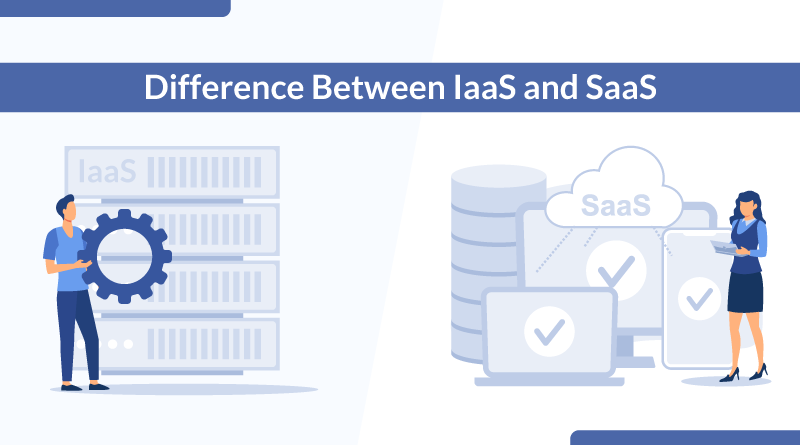With the growing technology demand, cloud computing is also increasing. Businesses worldwide have understood the importance of cloud computing and thus, prefer it to make their business operations run smoothly. This infrastructure is designed in such a manner that now it is not only considered as a service, but helps businesses in meeting their computing needs several times.
Now, there are multiple cloud delivery models that handle the loads of applications. Prominent ones are IaaS (Information as a Service) and SaaS (Software as a Service).
Any venture that needs to go online must be aware of these terminologies. They are very essential for you to know and today we are discussing IaaS vs SaaS.
So, for your convenience here is the blog highlighting major differences about them.
What is IaaS?
IaaS is a cloud computing delivery model that sets up the legacy on-premises systems to the cloud. Infrastructure as a Service (IaaS) is usually the first step in organizational planning that encourages a user to be given access to virtualized computing resources, including hardware, software, computing power, storage, networking, and other infrastructure elements.
The user, however, chooses which operating systems operate on the cloud infrastructure, the storage, and the apps that will be released. The user does not control the cloud infrastructure. IaaS offers cost-saving standardization, automation, and centralization that will improve user experience. In IaaS, users’ servers, software, hardware, and other infrastructure resources are hosted by external cloud service providers. Since the cloud provider manages everything by shifting hardware and virtualizing the cloud, businesses no longer need to buy and maintain their own equipment. Two of the most potent IaaS providers are VULTR, Azure and AWS.
What is SaaS?
Users can access and use cloud-based apps through the Internet thanks to the software delivery paradigm known as software as a service, or SaaS. These apps are readily available as a service using a straightforward interface, like a web browser. In SaaS, external software vendors handle everything, including data centre, backup, and system support in addition to programme maintenance. This is fundamentally dissimilar from the conventional on-premise service model, where businesses would pay a one-time price to get a perpetual licence but then later pay a recurring maintenance fee. Users were required to purchase a server, an operating system, a database licence, and a CRM system licence.
Related: 5 Tips To Choose The Best SaaS Hosting
What Are The Major Differences Between IaaS vs SaaS?
Model
From the cloud computing delivery model point of view IaaS and SaaS are different. IaaS on the one hand manages computing resources like servers, hardware, software, networks and others are saved in the cloud. And these resources are managed by cloud providers. Everything else, including the operating system, middleware, data, and application software, is entirely the user’s responsibility. The SaaS delivery paradigm, on the other hand, enables customers to connect to and use cloud-based apps through the Internet. In SaaS, the software suppliers handle every aspect of the users’ experience while the consumers utilise the services that are offered via a subscription-based business model.
Features
One of the most significant advantages of IaaS systems is that users only pay for the resources they really use because the services are provided on a subscription basis. IaaS offers cost-saving standardisation, automation, and centralization that will improve user experience. Additionally, the users have access to programmes that are GUI and API-based within the architecture of the service provider. With SaaS, consumers may access cutting-edge technology without having to make a significant financial commitment. The maintenance of the programme, upkeep of the data centre, backup, and system support are all handled by the software vendors.
Related: Everything You Need to Know about Cloud Computing [Features, Benefits, Challenges]
Advantages of IaaS
- Cloud providers can deploy IaaS resources any time into the customer’s environment.
- Users can easily scale the business based on requirements.
- IaaS providers have different options while deploying resources like networks, virtual machines, applications, storage.
- IaaS platforms can handle multiple users and they are easy to expand across different infrastructure.
- Lots of money is easy to save and companies use platforms to easily afford them with huge costs added in advanced technologies.
Advantages of SaaS
- This type of cloud computing delivery model offers an extensive range of hosted capabilities and services. Such platforms are useful to build and deploy web-based software applications.
- SaaS cloud computing delivery model minimizes the cost of on-premises software. It is because there is no requirement of installing hardware or licenses.
- Through a thin client and a browser, it is simple to access.
Conclusion
Cloud-based software servers make it easy for businesses to manage their technical infrastructure, create apps, and access a wide range of tools without having to buy or maintain a physical server. You can improve productivity and efficiency at your company with these services.








